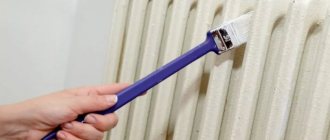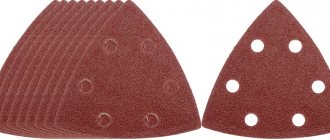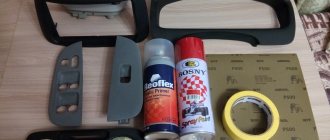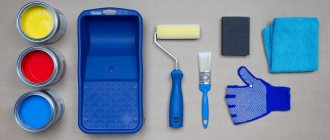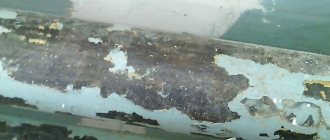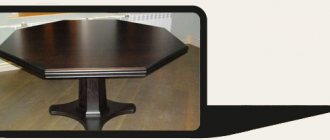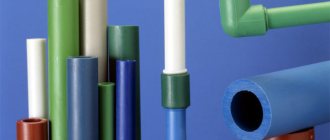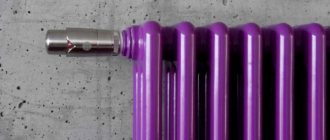Over time, old batteries lose their aesthetic appearance, rust appears, cracks appear in the coating, and paint peels off. Agree, changing the radiator in this case is not the best idea. It is much easier, faster and more economical to repaint the battery. Moreover, it is quite easy to update the appearance of the heating device.
We will help you choose the appropriate enamel composition, explain how to prepare and how to paint the heating radiator correctly. We will also outline the nuances that should be taken into account when working with different types of radiators.
The proposed photo ideas will inspire you to choose an interesting solution and implement your design idea.
How to paint heating radiators so as not to bite your elbows later?
During repairs, after installation, and also due to loss of the desired color, partial chips, the batteries must be painted.
Radiators are often repainted; if the color is not to your liking, you want to create a unified style in the room. The reason for painting may be minor scratches and chips, which often remain after installing the battery. Before you start painting, you should carefully consider all its nuances.
Then an excellent result is guaranteed. If the question arises “how to paint radiators?”, it is worth considering all the important points of this process.
Which batteries can be painted?
It’s worth clarifying right away that painting heating radiators is not possible in all cases. First of all, it is advisable to perform this operation for cast iron radiators, a thick and uneven layer of paint on which not only spoils the exterior of the battery, but also greatly impairs the quality of heat transfer. The second type of batteries that can and should be painted are convectors, made in the form of a bent riser pipe with fins pressed onto it.
Painting cast iron radiators
If you own modern models of radiators with aluminum sections, then it is better to abandon the idea of painting. Of course, you can paint it, but you will have to apply many layers of paint, and you are unlikely to achieve the expected effect. The fact is that the battery is painted with a brush, and this method is by definition worse than the factory one, so it is better to leave new battery models alone and, if necessary, cover it with a decorative screen.
How to remove old radiator paint
This can be done without draining the system, provided that the radiator is equipped with flow and check valves. In the case of a thermostatic valve, this means placing it in the position marked with an asterisk. After removing the plugs on the body valve (it is located on the down tube), it is screwed on using a hex wrench. You should be prepared for dirty water to come out of it, so have a cloth handy and a bowl under the valve. Once the fittings are loosened, water from the radiator will flow into the bowl. After draining the radiator, the threaded connections must be disconnected and then it can be removed. After painting the wall and letting the paint dry, we hang the radiator, reconnect it, loosen the bolt valve and then vent the radiator using the vent on the top of the radiator. The radiator is filled with water from below, which gradually pushes air through the vent. When water comes out of the vent, the radiator fills and the vent should be closed.
Dyeing technology
Before painting the heating radiator, it must be cleaned of the old coating. This can be done manually using a wire brush. You can also use a grinder with special attachments. Another option is to use special chemicals. For example, it is convenient to use aerosols, under the influence of which old paint easily peels off. After removing the paint, it is also necessary to get rid of rust, dirt, and thoroughly degrease the surface.
The cleaned surface must be thoroughly primed. To do this, select a primer recommended for use in conjunction with the selected paint.
After this, you can proceed directly to coloring. At least two brushes are used. One regular brush is used to paint external surfaces. The second brush should have a long curved handle. It easily penetrates into hard-to-reach places, so it is convenient for painting inside the radiator fins. Before use, you need to fluff the bristles of the brushes, which will help get rid of loose hairs. First, the internal surfaces are painted, and then the external ones. In this case, painting is done from top to bottom, which helps prevent the formation of streaks and drops. The radiator must be painted in two layers. In this case, the second layer is applied only after the first has completely dried.
Painting bimetallic and aluminum radiators
Modern aluminum and bimetallic radiators are already available with a paint coating. It is applied using powder coating at the factory. This coating is characterized by high protective properties, mechanical strength, wear resistance, and temperature resistance. Thanks to this, these radiators do not require painting during operation.
The exception is cases of mechanical damage to the radiator coating during transportation, installation, or operation. You can use automotive putty to remove chips and scratches. It is also best to paint damaged areas with auto enamel, the quality of which is comparable to the quality of the “native” coating. It is convenient to use aerosol cans for application. It should be taken into account that car enamel dries better and faster on hot radiators.
Painting recommendations
- The quality of painting of cast iron batteries also largely depends on how well they are prepared. A smooth foam roller of small diameter is optimal as a tool for applying paint, and a brush is useful in hard-to-reach places. To decide for yourself how to paint most conveniently, you should think about removing the batteries. The radiator, separated from the pipes, can be coated with the composition on all sides, so there will be significantly fewer hard-to-reach places. However, this method does not always pay off; sometimes it is easier to paint the battery more thoroughly without wasting time on removing it. It all depends on the specific circumstances and the shape of the radiator.
- A very important factor is the temperature of the surface to be painted: the radiator must be cold. To the question “is it possible to paint hot batteries?” any specialist will answer unequivocally: this cannot be done. The most convenient moment is when there is no heating season. But the beginning of the heating period will not be a hindrance if you close the valves on the radiators, stopping the access to boiling water. It is enough to wait until they cool completely to start painting. If paint is applied to a hot radiator, it will lie unevenly, swell, and various stains and stains will probably form. Moreover, you can turn on the heating only when the paint is completely dry.
ATTENTION: Never paint hot batteries!
- Painting radiators and heating pipes requires care and precision. It is good to use brushes, small rollers, and spray cans. It is optimal to use a spray gun to process the previously removed battery, then all hard-to-reach areas will be perfectly painted. It is from those places that are least accessible that you should start painting. It is important to maintain a uniform layer thickness, otherwise the color may further differ in different areas.
- It is recommended to start painting from the top, then accidental drips will not spoil the lower part. You need to cover the entire battery with the composition, not limited to its front part. It is more effective to apply paint in two thin layers, and wait until the first one has completely dried before painting again. Then there will be no drips, and it’s easier to achieve perfect evenness with thin layers.
Painting radiators - step-by-step instructions
We begin painting the radiator by thoroughly preparing its surface.
Step 1
First, make sure your device is cold. It's best to schedule repairs outside of the heating season, although this is also enough to turn the thermostat on a few hours earlier.
Batteries can only be painted when they are cold. This is best done at room temperature 10-20 o C and humidity less than 80%. Before painting, the radiator must be cleaned of old paint and rust, and then cleaned of dust. It is most convenient to paint radiators that are disconnected from the installation and removed from the wall. This procedure requires hiring a specialist or having certain skills.
Step 2
First of all, we will carefully protect the environment of the device - cover the wall around the radiator with wide paint tape and spread a protective film on the floor.
Step 3
Then remove any old, flaking paint. The easiest way is to use a coarse abrasive block.
The surface prepared for painting must be clean, dry and free of grease. After cleaning, the heater must be wiped with a damp cloth to collect dust. Radiators, especially those in the kitchen, probably have a layer of greasy deposits. Therefore, it is best to wash them with water and dishwashing liquid, then wipe them with clean water and let them dry.
Old paint and rust should be scraped off with a metal brush or coarse sandpaper, or an orbital or random orbital sander. We reach the recesses between the ribs by applying sandpaper to a small block. Pieces of old paint that are holding well should be sanded with fine sandpaper to ensure adhesion of the new paint.
Step 4
Matte the surface. If the coating is in good condition, instead of removing it, immediately begin matting the radiator with a fine-grit abrasive block.
Radiators with fins are best painted with a narrow brush with fairly long bristles on a very long shaft, which allows you to reach various nooks and crannies. To paint panel radiators, you can use a regular flat brush with medium bristles. Radiator paints can be applied by spray (they are also designed for small aerosol cans). If there are cavities on the surface to be painted after removing the old coating, it is good to paint only these areas first (to even out the thickness of the coating).
Batteries are painted 2-3 times. The interval between applying subsequent layers should be as long as indicated by the paint manufacturer. It could be half an hour or even 8 hours. As a rule, the surface should be dust-free, that is, not stick to the hand. Radiators can only be turned on 24 hours after painting.
Step 5
We clean the device - although most stains were removed during sanding, make sure there are no stubborn dirt or stains on the surface.
The importance of preparation
As in any serious matter related to repairs, the main attention should first be paid to proper preparation for this process. Otherwise, the result may turn out much worse than expected.
Timing
The preparatory procedures last even longer than the painting itself.
The first thing to remember is that all work on painting radiators should be carried out after the end of the heating season. Otherwise, it will be very difficult to achieve excellent results.
If this is not possible, then you need to at least turn off the hot water. You can contact the housing office specialists for help. When the batteries have cooled down noticeably, it's time to start working.
Cleaning
Before applying paint, all surfaces should be cleaned of dust and accumulated grease.
Radiators are no exception. To remove dust, you can:
- Use dry cleaning. To do this, you need a hand-held vacuum cleaner or a regular brush/rag/sponge.
- Use wet cleaning with water and a sponge.
Fat accumulated on the battery must also be cleaned. To get rid of it, just use regular dishwashing detergent and a sponge. After the battery has been washed, you need to leave it to dry.
Removing peeling paint
There are several ways to clean a radiator from paint that has peeled off and peeled off over time.
Brush
It is quite possible to remove old paint using a metal scraper. But this is a very labor-intensive process and will take a long time. Of course, if there is no alternative, this method will be quite useful.
Bulgarian
A grinder with a special attachment (in the form of a metal brush) will greatly simplify and speed up the process of cleaning the old layer.
Expert opinion
Grebnev Vadim Savelievich
Heating system installer
When using an angle grinder, you need to control the operation at high speeds. It is very easy to damage the surface of the radiator along with the paint layer.
Removing all coating is not optional. It will be enough to get rid of the cracked areas.
Chemicals
Using special chemical compounds, it is very easy to wash off the old paint from the radiator.
There are several types of such solvents:
- Gels and pastes. Such compositions must be applied directly to the battery using a brush (with natural bristles). Then you need to leave them on the radiator for the required time. For different media it may
vary from a few minutes to several hours. To make the effect even better, you can cover the battery with the chemical composition with a polyethylene film. When the paint softens, all you need to do is remove it from the battery using a spatula or brush. - Sprays and aerosols . Such substances are very convenient to apply to the battery, even to the most inaccessible areas. After a few minutes to an hour, they begin to actively act and soften the paint. After that, you can simply remove it with a brush.
Working with chemical compounds is not safe. Due to fumes, procedures must be carried out in a ventilated area. During work, it is imperative to use goggles and gloves, and, if possible, a protective respirator. Before use, it is a good idea to make sure that the metal from which the radiator is made will not react with the chemical composition, otherwise the surface of the battery may be damaged.
Padding
Once the old paint has been successfully removed from the surface, the radiator should be primed well. This process is used to remove minor imperfections, scratches and cracks. It is better to treat batteries made of steel or copper with sandpaper, and cast iron with a regular metal brush. Then the battery needs to be degreased again and proceed to the primer itself.
The composition for the primer must combine the following characteristics:
- Designed for metal surfaces.
- Protect from rust.
- Be compatible with paint.
The best way to paint hot batteries
Exposure to hot water causes premature failure of heating radiators - over time, pockets of corrosion are found on the metal surface. To prevent this process, special types of paint should be used to paint batteries.
A high-quality paint composition must withstand elevated temperatures well, have a stable film structure and maintain its original tone for a long time. In addition, if the owner prefers to carry out repairs in winter, it is advisable to choose paint without a strong odor .
To paint heating radiators during the heating season, it is recommended to use the following types of paint:
- Alkyd. This material does not have a strong odor, retains its original shade for a long time and is excellent for interior metal work;
- Acrylic. Paints based on this base have excellent resistance to elevated temperatures and are ideal for application to household heating radiators. Acrylic compositions retain color for a long time, but have an unpleasant odor, so the use of these paints for interior work is limited. There is a variety of acrylic paints that need to be mixed with special solvents; they are distinguished by higher covering qualities and an impeccable glossy film, and to apply this paint no preliminary primer of the surface is required;
- Oily. Durable and reliable paints, but they have a significant drawback - the drying time is too long.
In addition to the paints listed, aerosol cans with auto enamel can be used to paint radiators. The sprayer greatly facilitates the work and allows you to use material economically.
choosing a paint brand The choice of paints on the market is quite wide. But when choosing a brand based on technical characteristics, you should take into account some nuances:
- The temperature of the working surface of the battery being painted is 80-900 Celsius, i.e. the paint must be sufficiently heat-resistant;
Due to the effects of temperature, the metal of pipes and radiators is subject to increased corrosion, which means that the paint composition must have anti-corrosion properties.
- The high temperature of the heating device over time also negatively affects the color of the paint - it fades, i.e. pay attention to the color fastness of the paint composition.
Pre-cleaning of heating devices before painting
It consists of three operations: Cleaning. Before applying the decorating composition to the battery, its surface should be thoroughly cleaned, not forgetting, as already mentioned, the need to evenly apply a layer of paint and preserve the heat transfer of the radiator. Degreasing. The entire painted surface of batteries and pipes must be washed from dirt and dust and treated with any degreasing liquid (acetone, white spirit). Primer. To create better adhesion (adhesion) of the base paint layer to the surface, the latter is covered with a layer of primer, the thickness of which significantly affects the heat transfer efficiency of the device, especially those made of cast iron, and heat supply pipes, as well as the anti-corrosion properties of the metal.
The need to paint the battery
There are times when painting a heating radiator is not just a whim of the owners, but really a necessity caused by certain factors.
So, the unit should be coated with a coloring compound if:
Regardless of how to paint cast iron batteries, it is very important to carry out the necessary preparatory work to make the paint easier to apply and dry better on the radiator.
In addition, it is very important that painting cast iron batteries does not in any way affect the heat transfer performance of the device, otherwise the performance of the equipment will significantly decrease.
Possible problems when painting
When implementing each stage of work, unexpected difficulties may arise - the paint does not apply evenly or the old coating is not removed. In order not to spoil the materials, you can pause work, wait for complete drying and start again by cleaning and degreasing the surface.
You can find out what paint to paint heating radiators from consultants in a specialized store; they will help you decide on a specific brand that is most popular among customers.
To avoid additional difficulties, pay attention to the video instructions, where experts will help you study the painting algorithm in detail and follow the detailed steps.
What paint should I use for radiators?
The paint you apply to the batteries must meet certain requirements. The paint material chosen must be suitable for metal coating. The paint must withstand prolonged temperatures of at least 90 ° C degrees; it is also important that the composition does not contain toxic substances, and that the coating is resistant to abrasion. The composition applied to the surface of a metal radiator must have good adhesion to the surface and not peel off when the heating device heats up and cools down. An excellent choice would be Dulux Master Lux Aqua paint, designed for radiators and furniture. It not only meets all the necessary requirements, but also has excellent coverage, is easy to apply and dries quickly, and has almost no odor. In addition, it can be tinted in the same shades as Dulux wall paints, which opens up additional possibilities for you in remodeling your interior.
Odorless paint
Water-dispersed acrylic enamels or paints do not have a strong odor. In addition, it quickly dissipates. It is necessary to buy paint that has a special composition for painting batteries or is suitable for radiators. The temperature regime must also be indicated.
This type of paint and enamel is applied evenly to the surface and dries quickly. Over time, the radiator will not turn yellow and the paint will not crack. There are semi-gloss and gloss paints. The main requirement for such paints is the obligatory primer of the surface. If this is not done, then after a while the radiator will become covered with rust.
It is convenient to use paint not in a can, but in a spray can. It will be applied smoothly and quickly. But before painting, it is necessary to cover all surfaces that may accidentally become painted. Otherwise, it will take a long time to wash everything.
There is a huge selection of paints and enamels for radiators on the market. You need to decide on the desired color, as well as the type of paint: matte, glossy or semi-gloss. It is worth deciding in advance which enamel is more suitable for you: alkyd or acrylic. You can also pre-read reviews about manufacturers. All colors have their positive sides. The only type that is not recommended for use is oil paints.
